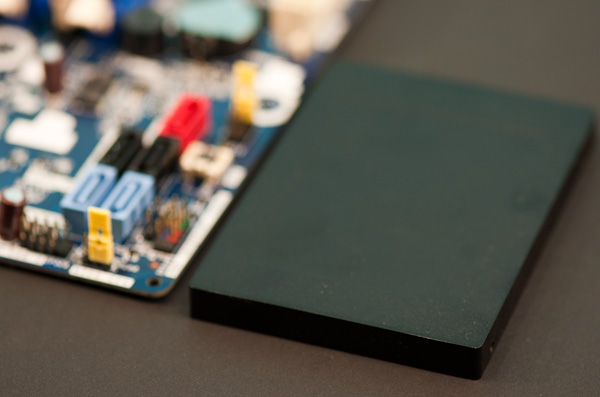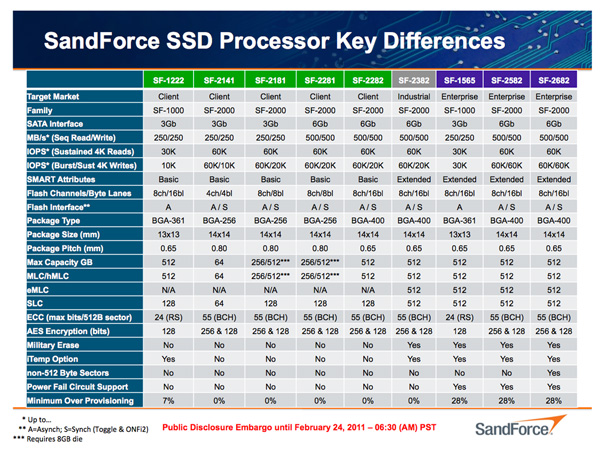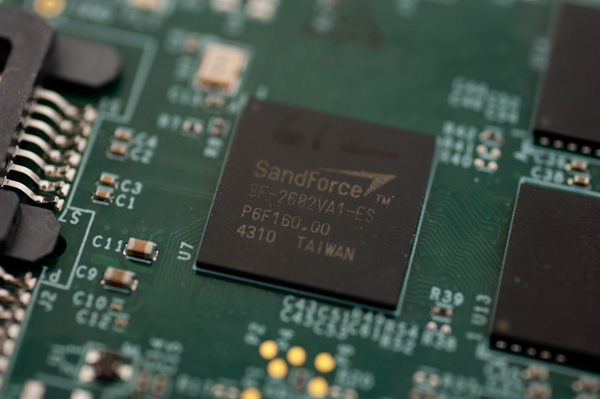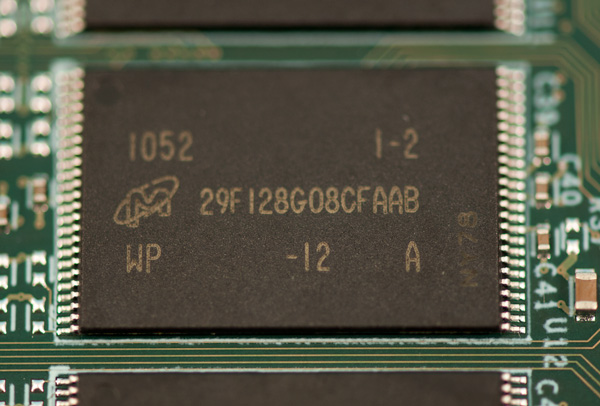OCZ Vertex 3 Preview: Faster and Cheaper than the Vertex 3 Pro
by Anand Lal Shimpi on February 24, 2011 9:02 AM ESTLast week OCZ pulled the trigger and introduced the world’s first SF-2000 based SSD: the Vertex 3 Pro. Not only was it the world’s first drive to use SandForce’s 2nd generation SSD controller, the Vertex 3 Pro was also the first SATA drive we’ve tested to be able to break 500MB/s on both reads and writes. Granted that’s with highly compressible data but the figures are impressive nonetheless. What wasn’t impressive however was the price. The Vertex 3 Pro is an enterprise class drive, complete with features that aren’t exactly in high demand on a desktop. As a result the V3P commands a premium - the drive starts at $525 for a 100GB capacity.
Just as we saw last round however, if there’s a Vertex 3 Pro, there’s bound to be a more reasonably priced non-Pro version without some of the enterprisey features. Indeed there is. Contained within this nondescript housing is the first beta of OCZ’s Vertex 3 based on a SandForce SF-2200 series controller. The price point? Less than half of that of the V3P:
| Pricing Comparison | |||||
| 128GB | 256GB | 512GB | |||
| OCZ Vertex 3 Pro | $525 (100GB) | $775 (200GB) | $1350 (400GB) | ||
| OCZ Vertex 3 | $249.99 | $499.99 | N/A | ||
At an estimated $250 for a 120GB drive the Vertex 3 is more expensive than today’s Vertex 2, but not by too much nor do I expect that price premium to last for long. The Vertex 2 is on its way out and will ultimately be replaced by the V3. And SSD prices will continue to fall.
What sets a Vertex 3 apart from a Vertex 3 Pro? Not all that much, but SandForce has grown a lot in the past year and instead of just a couple of SKUs this time around there are no less than seven members of the SF-2000 family.
You should first know that SandForce only produces a single die, the differences between all of the members of the SF-2000 family are strictly packaging, firmware and testing.
The main categories here are SF-2100, SF-2200, SF-2500 and SF-2600. The 2500/2600 parts are focused on the enterprise. They’re put through more aggressive testing, their firmware supports enterprise specific features and they support the use of a supercap to minimize dataloss in the event of a power failure. The difference between the SF-2582 and the SF-2682 boils down to one feature: support for non-512B sectors. Whether or not you need support for this really depends on the type of system it’s going into. Some SANs demand non-512B sectors in which case the SF-2682 is the right choice.
You may remember that our Vertex 3 Pro sample used a SF-2682 controller. That’s because initially all SandForce made were SF-2682s. Final versions of the V3P will likely use the cheaper SF-2582.
The SF-2200/2100 series are more interesting because of their lower target price points. You lose support for the supercap but that’s not as big of a deal on the desktop since you’re not working with mission critical data. The big difference between the 2200 and 2100 is support for 6Gbps SATA, the former supports it while the latter doesn’t. This is a pretty big difference because as we’ve seen, when paired with a 3Gbps controller the SF-2000 isn’t too much better than what we had with the SF-1000.
The other big difference is the number of byte lanes supported by the controller. The SF-2181 and above all support 8 NAND flash channels, however only the SF-2282 supports 16 byte lanes. Each NAND device is 8 bytes wide, supporting 16 byte lanes means that each channel can be populated by two NAND devices. This lets a single SF-2282 controller talk to twice as many NAND devices as a SF-2281.
There’s no performance difference between the 8 and 16-byte lane versions of the chip, it’s just a matter of pure capacity. Thankfully with 25nm NAND you can get 8GB of MLC NAND on a single die so both the 2281 and 2282 should be able to hit 512GB capacities (the 2281 simply needs higher density NAND packages).
The Vertex 3 sample we have here today uses the SF-2281. Our sample came configured with sixteen 16GB Micron 25nm ONFI 2.0 NAND devices. Remember that while both Intel and Micron own the 25nm fabs, the two companies are providing different specs/yields on 25nm NAND. The 25nm Micron stuff is rated at around 3,000 p/e cycles from what I’ve heard, while the Intel 25nm is rated at 5,000. The main difference here is that the Micron is available in great quantities today while the Intel 25nm isn’t.
RAISE: Optional
One other difference between the SF-2500/2600 and the SF-2100/2200 is the optional nature of RAISE. You'll remember that in order to allow for lower quality NAND SandForce stripes a small amount of redundant data across the array of NAND in a SF-1000/2000 drive. SandForce never stores your actual data, rather a smaller hash/representation of your data. When your data is compressed/deduped for storage, SandForce's controller also generates parity data equal to the size of a single NAND die in the array. This process is known as RAISE (Redundant Array of Independent Silicon Elements) and it allows you to lose as much as a full NAND die worth of data and still never see a bit of data loss from the user's standpoint. At 25nm however a single die can be as large as 8GB, which on a lower capacity drive can be a significant percentage of the total drive capacity.

With the SF-2100/2200, SandForce allows the manufacturer to disable RAISE entirely. At that point you're left with the new 55-bit BCH ECC engine to do any error correcting. According to SandForce the new BCH ECC engine is sufficient for dealing with errors you'd see on 25nm NAND and RAISE isn't necessary for desktop workloads. Drive makers are currently contemplating what to do with RAISE but as of now the Vertex 3 is set to ship with it enabled. The drive we have here today has 256GB of NAND, it'll be advertised as a 240GB drive and appear as a 223.5GB drive in Windows.
Here We Go Again: 4KB Random Write IOP Caps
With the SF-1200 SandForce capped the peak 4KB random write speed of certain drives while negotiating exclusive special firmware deals with other companies to enable higher performance. It was all very confusing as SandForce shipped initial firmware revisions with higher performance and later attempted to take that performance away through later firmware updates.
If you pay attention to the table above you’ll notice that there are two specs for 4KB random write IOPS: burst and sustained. The burst value is for around 15 seconds of operation, the sustained is what happens when the firmware initiated performance cap kicks into action. By default the SF-2100/2200 drives have a cap of 20,000 IOPS for 4KB random writes. After a period of about 15 seconds, the max performance on these drives will drop to 20K. The SF-2500/2600 controllers are uncapped, max performance can remain at up to 60K IOPS.
The beta Vertex 3 review sample I have here today manages around 45K IOPS in our 4KB random write test. That test runs for 3 minutes straight so obviously the cap should’ve kicked in. However it didn’t.
I asked SandForce why this was. SandForce told me that the initial pre-release firmwares on the SF-2200 drives don’t have the cap enabled, but the final release will put the cap in place. I also asked SandForce if it was possible for one of its partners to ship with a special firmware build that didn’t have the cap in place. SandForce replied that anything was possible.
I asked OCZ if this meant the drive I was testing wasn’t representative of final, shipping performance. OCZ stated very clearly that performance will not change between the drive I have today and the drive that goes on sale in the next 2 months. To me this sounds like SF and OCZ have struck another exclusive firmware deal to ensure slightly higher performance on the Vertex 3 compared to a standard SF-2200 based drive.
SandForce wouldn’t comment on any existing agreements and OCZ said it couldn’t get SandForce to confirm that the V3’s performance wouldn’t change between now and its eventual release. Based on what we saw last time I expect SandForce to offer the 60K IOPS firmware to all partners that meet certain order size commitments. Order enough controllers and you get a special firmware, otherwise you’re stuck with the stock SF-2200 firmware.
Of course this makes things very confusing for those of you looking to shop around when buying a SF-2200 drive. I do wish SandForce would just stick to a single spec and not play these sorts of games but that’s just how business works unfortunately.
The good news is that for most desktop workloads you don’t really benefit from being able to execute more than 20K IOPS, at least in today’s usage models.
















85 Comments
View All Comments
Mr Perfect - Thursday, February 24, 2011 - link
I hate to bring this up here, but this should be addressed and you seem to have a direct line to the OCZ CEO(all be it in sticky notes). Can AT look into the fiasco where OCZ shipped 8 channel 25nm Vertex 2 drives bearing the exact same name and model number as the origonal 16 channel 34nm drives, and then when customers noticed the difference decided to charge people an upgrade fee to get a 16 channel drive? True, OCX later relented after a negative backlash and gave people free exchanges for a 16 channel drive, but I can't think of a faster way to burn through customer good will then a bait and switch stunt like that. What happened?http://www.storagereview.com/ssds_shifting_25nm_na...
FunBunny2 - Thursday, February 24, 2011 - link
Yeah. AT *seems* to be easier on OCZ than storagereview. I can't speak for their quality overall as I've only read up on what they had to say about this OCZ Vertex nonsense. I'm not going to abandon AT. Yet, anyway.semo - Thursday, February 24, 2011 - link
It wasn't always the case. When Anand exposed jmicron's awfulness to the world, OCZ's CEO wasn't happy at all (the surprising thing is Anand actually mentioning this back then).The two things that surprise me the most are:
1. Why didn't Anandtech as a whole report on 25nm drives. AFAIK OCZ were the first with commercial 25nm drives. Now if a commercial x86 CPU was about to be released in the next 6 months, AT would be all over that story...
2. A lot of time has passed, and there is still no coverage on OCZ's dishonest practices. If a decent site (like AT) covered these drives early enough, a lot less people would have fallen in OCZ's trap.
Anand did mention in his previous article that he would look in to the issue.
I've seen the discussion and based on what I've seen it sounds like very poor decision making on OCZ's behalf. Unfortunately my 25nm drive didn't arrive before I left for MWC. I hope to have it by the time I get back next week and I'll run through the gamut of tests, updating as necessary. I also plan on speaking with OCZ about this. Let me get back to the office and I'll begin working on it
As far as old Vertex 2 numbers go, I didn't actually use a Vertex 2 here (I don't believe any older numbers snuck in here). The Corsair Force F120 is the SF-1200 representative of choice in this test.
Take care,
Anand
http://www.anandtech.com/show/4159/ocz-vertex-3-pr...
semo - Thursday, February 24, 2011 - link
"Now if a commercial x86 CPU" should have been "Now if a commercial 14nm x86 CPU". Usually new tech in the CPU, GPU and now SoC segments gets covered quite early and thoroughly. Somehow the 25nm Vertex 2 flew under the radar it seems...Anand Lal Shimpi - Thursday, February 24, 2011 - link
I've been working with OCZ behind the scenes on this. I've been tied up with the reviews you've seen this week (as well as some stuff coming next week) and haven't been able to snag a few 25nm drives for benchmarking. Needless to say I will make sure that the situation is rectified. I've already been speaking with OCZ's CEO on it for the past week :)Take care,
Anand
lyeoh - Thursday, February 24, 2011 - link
Hi Anand,Is it possible to do average and max latency measurements on the drive access (read/write) while under various loads (sequential, random, low queue depth, high queue depth)?
I'm thinking that for desktop use once a drive gets really fast, the max latency (and how often it occurs) would affect the user experience more.
A drive with 0.01 millisecond access but 500ms spikes every 5 secs under load might provide a worse user experience than a drive with a constant 0.1 millisecond access even though the former averages at about 80000 accesses per second while the latter only achieves 10000. Of course it does depend on what is delayed for 500ms. If it's just a bulk sequential transfer it might not matter, but if it delays the opening of a directory or small file it might matter.
This might also be important for some server use.
jimhsu - Thursday, February 24, 2011 - link
This is needed -- however there are a lot of technical problems when trying to assess max latency. One of those is reproducibility -- if the drive has a latency of 0.01ms, but a max of 250ms, how reliable is that data point? What if something just happens to be writing to the drive while you make that measurement? (This can easily be seen by trying to do 4K reads when doing a sequential write larger than the DRAM cache of the SSD, such as the Intel G2 drives). From my personal observations, website to website reproducibility of maximum latencies, as well as minimum frame rates in reviews, is extremely poor.Which is unfortunate, because they can impact user experience so heavily. Aside from strict laboratory-controlled conditions and testing with specialized equipment, I find it hard to conjecture how to do this.
semo - Thursday, February 24, 2011 - link
"haven't been able to snag a few 25nm drives"So OCZ are sending you Vertex drives for testing so early that they don't even have housing and you're stuggling to get a hold of drives that have been sold to consumers for the past month or two?
How come you have V3 drives months before their release date and AT does not yet even have a news article on the 25nm V2s?
I'm sorry Anand but this will be the 1st SSD article you've written that I will not be reading. This is in protest to OCZ's handling of this CONSUMER RIGHTS issue. I'm not protesting against AT but OCZ's propaganda which unfortunately is channeled through my No 1 favourite site.
Ryan Petersen, you know where to stick it.
seapeople - Thursday, February 24, 2011 - link
Yeah, I can't imagine why OCZ isn't knocking Anand's door down with review samples of 25nm SSD drives after that big customer snafu with their 25nm drives. I mean, they should be eager to have all the publicity on that issue as possible, right?And then why on earth would they rather send their newest, fastest SSD drives to a review site right now? They must know that Anand is probably busy reviewing the other SSD drives that are about to come out, so why would they bother him with their new stuff?
beginner99 - Thursday, February 24, 2011 - link
That's why I would just go with Intel. I know what you pay for. No custom firmwares and other funky stuff.